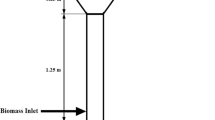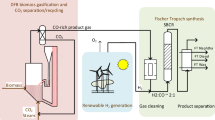Abstract
Energy waste from power plants, typically emitted into the atmosphere, contributes to climate change and resource depletion. Integrating heat recovery systems into power plants can improve overall efficiency. This study focused on utilizing waste heat from a 500-MWe coal-based supercritical standalone plant through the organic Rankine cycle. The power plant uses Indian coal as a fuel input, and five distinct working fluids, R245fa, methanol, acetone, ethanol, and benzene, are considered working fluids for the ORC system. Thermodynamic analysis indicates that the standalone plant exhibits energy and exergy efficiencies of 27.33% and 25.01%, respectively. Following the integration of ORC, an overall efficiency improvement is observed. The increment in efficiency is because of the waste heat utilization, where the ORC generates additional electricity generation with outputs of 9.91 MWe for R245fa, 13.71 MWe for methanol, 13.97 MWe for acetone, 14.04 MWe for ethanol, and 14.11 MWe for benzene. Additionally, the study reveals a substantial reduction in CO2 emissions compared to the coal-based power plant with the same production of power, amounting to approximately 216.43 tons for R245fa, 299.43 tons for methanol, 305.10 tons for acetone, 306.63 tons for ethanol, and 308.16 tons for benzene. The thermodynamic investigation identifies the superior performance of the benzene-based ORC among the chosen fluids, and the economic study concludes that the ethanol-based ORC stands out as the most favorable option among the considered alternatives.










Similar content being viewed by others
Abbreviations
- H :
-
Specific enthalpy (kJkg−1)
- \(\dot I\) :
-
Irreversibility rate (kW)
- \(\dot m\) :
-
Mass flow rate (kgs−1)
- N :
-
Molar flow rate (kmols−1)
- Q :
-
Heat transfer rate (kW)
- ∆T :
-
Temperature difference (°C)
- \(\dot W\) :
-
Work rate (kW)
- \(\dot E\;\) :
-
Exergy rate (kW)
- \({\dot W_{{\text{waste}}}}\) :
-
Exergy rate of the recovered waste heat (kW)
- ₹:
-
Indian currency symbol (Rupees)
- Z:
-
Cost of each component (Rupees)
- η :
-
Energy efficiency (%)
- ε :
-
Exergy efficiency (%)
- \({\Psi }\) :
-
Specific exergy (kJkg−1)
- LMTD:
-
Logarithmic mean temperature difference
- ORC:
-
Organic Rankine cycle
- min:
-
Minimum
- cv:
-
Control volume
- max:
-
Maximum
References
Executive summary power sector. New Delhi: Government of India, Ministry of Power, Central Electricity Authority. 2023. http://www.cea.nic.in/reports/monthly/executive-summary-report/.pdf. Accessed from 20 Jun 2023.
Ahmadi B, Golneshan AA, Arasteh H, Karimipour A, Bach QV. Energy and exergy analysis and optimization of a gas turbine cycle coupled by a bottoming organic Rankine cycle. J Therm Anal Calorim. 2020. https://doi.org/10.1007/s10973-019-09088-6.
Senturk AM. Multi-stage artificial neural network structure-based optimization of geothermal energy powered Kalina cycle. J Therm Anal Calorim. 2021. https://doi.org/10.1007/s10973-020-10125-y.
Sheshpoli MA, Ajarostaghi SS, Delavar MA. Thermodynamic analysis of waste heat recovery from hybrid system of proton exchange membrane fuel cell and vapor compression refrigeration cycle by recuperative organic Rankine cycle. J Therm Anal Calorim. 2019. https://doi.org/10.1007/s10973-018-7338-0.
Uusitalo A, Honkatukia J, Turunen-Saaresti T, Larjola J. A thermodynamic analysis of waste heat recovery from reciprocating engine power plants by means of Organic Rankine Cycles. Appl Therm Eng. 2014. https://doi.org/10.1016/j.applthermaleng.2014.04.073.
Hosseini SE, Butler B. Design and analysis of a hybrid concentrated photovoltaic thermal system integrated with an organic Rankine cycle for hydrogen production. J Therm Anal Calorim. 2021. https://doi.org/10.1007/s10973-020-09556-4.
Wang J, Yan Z, Wang M, Ma S, Dai Y. Thermodynamic analysis and optimization of an (organic Rankine cycle) ORC using low grade heat source. Energy. 2013. https://doi.org/10.1016/j.energy.2012.11.009.
Zhao L, Bao J. Thermodynamic analysis of organic Rankine cycle using zeotropic mixtures. Appl Energy. 2014. https://doi.org/10.1016/j.apenergy.2014.03.067.
Mirzaei M, Ahmadi MH, Mobin M, Nazari MA, Alayi R. Energy, exergy and economics analysis of an ORC working with several fluids and utilizes smelting furnace gases as heat source. Therm Sci Eng Prog. 2018. https://doi.org/10.1016/j.tsep.2017.11.011.
Mitri FB, Ponce G, Anderson KR. Compost waste heat to power organic Rankine cycle design and analysis. J Energy Resour Technol. 2023. https://doi.org/10.1115/1.4062288.
Mohammadi A, Kasaeian A, Pourfayaz F, Ahmadi MH. Thermodynamic analysis of a combined gas turbine, ORC cycle and absorption refrigeration for a CCHP system. Appl Therm Eng. 2017. https://doi.org/10.1016/j.applthermaleng.2016.09.098.
Javanshir A, Sarunac N. Thermodynamic analysis of a simple organic Rankine cycle. Energy. 2017. https://doi.org/10.1016/j.energy.2016.12.019.
Mudasar R, Aziz F, Kim MH. Thermodynamic analysis of organic Rankine cycle used for flue gases from biogas combustion. Energy Convers Manag. 2017. https://doi.org/10.1016/j.enconman.2017.10.034.
Wang T, Zhou T, Feng Y, Zhang M, Zhu S, Yang H. Poly-generation system with waste heat of low-temperature flue gas in power plants based on organic Rankine cycle. Appl Therm Eng. 2024. https://doi.org/10.1016/j.applthermaleng.2024.122513.
Senturk Acar M, Arslan O. Energy and exergy analysis of solar energy-integrated, geothermal energy-powered organic Rankine cycle. J Therm Anal Calorim. 2019. https://doi.org/10.1007/s10973-018-7977-1.
Xue K, Wang J, Zhu X, Ma S, Fan J, Zhao R. Energy and exergy analysis of waste heat recovery from pressurized hot smothering steel slag by solar organic Rankine cycle. J Therm Anal Calorim. 2023. https://doi.org/10.1007/s10973-023-12408-6.
Wilberforce T, Muhammad I. Dynamic modelling and analysis of organic Rankine cycle power units for the recovery of waste heat from 110kW proton exchange membrane fuel cell system. Int J Thermofluids. 2023. https://doi.org/10.1016/j.ijft.2023.100280.
Cycle–Tempo Release 5.0. Delft University of Technology. 2008. http://www.tudelft.nl
Karmakar S. Thermodynamic analysis of 500 MWe Supercritical power plant using high‐ash coal with carbon dioxide capture. PhD Thesis: IIT Madras; 2016.
Tiwari D, Sherwani AF, Atheaya D, Kumar A, Kumar N. Thermodynamic analysis of Organic Rankine cycle driven by reversed absorber hybrid photovoltaic thermal compound parabolic concentrator system. Renew Energy. 2020. https://doi.org/10.1016/j.renene.2019.10.018.
Liu BT, Chien KH, Wang CC. Effect of working fluids on organic Rankine cycle for waste heat recovery. Energy. 2004. https://doi.org/10.1016/j.energy.2004.01.004.
Mosaffa AH, Mokarram NH, Farshi LG. Thermoeconomic analysis of a new combination of ammonia/water power generation cycle with GT-MHR cycle and LNG cryogenic exergy. Appl Therm Eng. 2017. https://doi.org/10.1016/j.applthermaleng.2017.06.126.
Mahmoudi SM, Pourreza A, Akbari AD, Yari M. Exergoeconomic evaluation and optimization of a novel combined augmented Kalina cycle/gas turbine-modular helium reactor. Appl Therm Eng. 2016. https://doi.org/10.1016/j.applthermaleng.2016.08.011.
Özahi E, Tozlu A, Abuşoğlu A. Thermoeconomic multi-objective optimization of an organic Rankine cycle (ORC) adapted to an existing solid waste power plant. Energy Convers Manag. 2018. https://doi.org/10.1016/j.enconman.2018.04.103.
Ghaebi H, Namin AS, Rostamzadeh H. Exergoeconomic optimization of a novel cascade Kalina/Kalina cycle using geothermal heat source and LNG cold energy recovery. J Clean Prod. 2018. https://doi.org/10.1016/j.jclepro.2018.04.049.
AlZahrani AA, Dincer I. Exergoeconomic analysis of hydrogen production using a standalone high-temperature electrolyzer. Int J Hydrog Energy. 2021. https://doi.org/10.1016/j.ijhydene.2020.04.055.
Sayyaadi H, Khosravanifard Y, Sohani A. Solutions for thermal energy exploitation from the exhaust of an industrial gas turbine using optimized bottoming cycles. Energy Convers Manag. 2020. https://doi.org/10.1016/j.enconman.2020.112523.
Sohani A, Hoseinzadeh S, Berenjkar K. Experimental analysis of innovative designs for solar still desalination technologies; an in-depth technical and economic assessment. J Energy Storage. 2021. https://doi.org/10.1016/j.est.2020.101862.
Wang ZQ, Zhou NJ, Guo J, Wang XY. Fluid selection and parametric optimization of organic Rankine cycle using low temperature waste heat. Energy. 2012. https://doi.org/10.1016/j.energy.2012.02.022.
West Bengal Electricity Regulatory Commission, 2023 https://wberc.gov.in/sites/default/files/TP98.pdf. Accessed from 26 Jun 2023.
Lecompte S, Ameel B, Ziviani D, van den Broek M, De Paepe M. Exergy analysis of zeotropic mixtures as working fluids in Organic Rankine cycles. Energy Convers Manag. 2014. https://doi.org/10.1016/j.enconman.2014.02.028.
Mittal ML, Sharma C, Singh R. Estimates of emissions from coal fired thermal power plants in India. In: International emission inventory conference. 2012; pp. 13–16
Safarian S, Aramoun F. Energy and exergy assessments of modified organic Rankine cycles (ORCs). Energy Rep. 2015. https://doi.org/10.1016/j.egyr.2014.10.003.
Carbon Credit Capital. 2023 https://carboncreditcapital.com/.Accessed. Accessed from 26 Jun 2023.
Author information
Authors and Affiliations
Contributions
NKC was involved in data curation, methodology, and writing—original draft preparation. SK helped with conceptualization, reviewing, and editing.
Corresponding author
Additional information
Publisher's Note
Springer Nature remains neutral with regard to jurisdictional claims in published maps and institutional affiliations.
Rights and permissions
Springer Nature or its licensor (e.g. a society or other partner) holds exclusive rights to this article under a publishing agreement with the author(s) or other rightsholder(s); author self-archiving of the accepted manuscript version of this article is solely governed by the terms of such publishing agreement and applicable law.
About this article
Cite this article
Choudhary, N.K., Karmakar, S. Thermoeconomic analysis of organic Rankine cycle with different working fluids for waste heat recovery from a coal-based thermal power plant. J Therm Anal Calorim (2024). https://doi.org/10.1007/s10973-024-13142-3
Received:
Accepted:
Published:
DOI: https://doi.org/10.1007/s10973-024-13142-3




